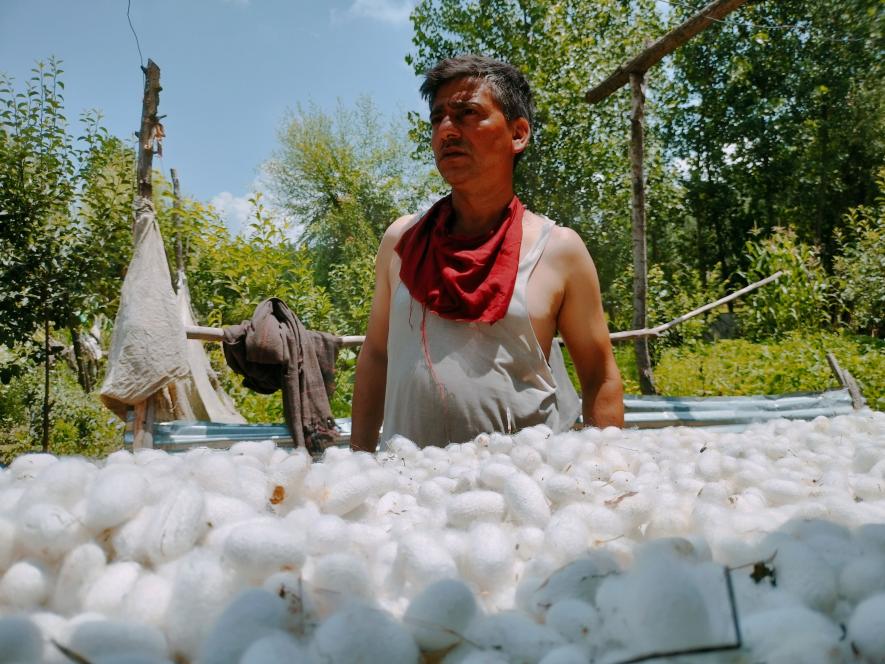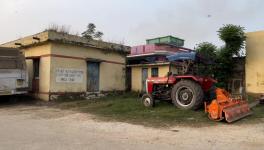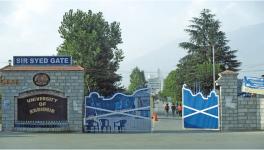Kashmir Silk Weavers Strive Hard to Stay Afloat

Muhammad Shaban Bhat switched from carpet weaving to silk rearing a decade ago.
Divar/Parihaspora: Muhammad Shaban Bhat weaved expensive Kashmiri rugs from dawn until dusk for more than a decade. A Qalbaf, or carpet weaver, slogs for hours only to make little profit. Finally, Bhat gave up his profession as struggles mounted.
A decade later, Bhat started rearing silkworms at his residence in Udina village of Sumbal, about 25 km from Srinagar. He turned his small home, lined by vegetable plants, cornstalks and willow trees, into a silk storeroom. The family, including Bhat’s two daughters and a son, are busy harvesting cocoons these days.
“Working on carpets was difficult as I couldn’t earn much. In the case of silk rearing, the more hard work you do, the better it pays,” Bhat tells Newsclick.
Cocoon harvesting starts in the last week of May and continues till June. About 27,000 families are involved in sericulture in all districts across the region. Most of these families, like Bhat’s, belong to the economically weaker section.
According to official data, Jammu and Kashmir (J&K) produced 800 million tonnes (MT) of cocoons during 2019-20 with income generation of Rs 25 crore under the pre-cocoon sector. J&K produces some of the world’s finest silk-based products, including silk carpets and Kashmiri shawls, valued at approximately Rs 300 crore.
The silk seed station in Migrund, Baramulla.
Bhat lives closer to one of the biggest silk seed stations providing seeds to cocoon rearers, or Kiram Kash, like him. The nursery, established over 1,400 kanals, aids families across Kashmir and is known for its “best climate” for Bivoltine silkworm rearing.
The government has made several efforts to revive the silk industry in the region after its decline in the past few decades. The Directorate of Sericulture was established in Kashmir around 1897 under CW Walton, a prominent European sericulturist, as the then-maharaja government highly incentivised working in the sector. After gaining prominence, there was a slump and workers protested for minimum wages.
The government has since provided rearers an improved variety of silk seeds free of cost. Reeling and weaving of cocoons is done mainly in rural areas, where sericulture department officers train more hands to increase production. The administration aims to improve the post-cocoon sector, introduce sericulture in unrepresented areas, and encourage private participation.
Bhat’s home is filled with waste and dust emerging from the harvest. It is difficult to live and eat in the same place where weaving and reeling are done. “It badly affects our health,” he says.
The Union Territory administration is aiding farmers like Bhat through a central scheme called Silk Samgra 2, providing financial assistance to set up units, purchase equipment, and train farmers and silk producers on modern sericulture techniques.
A sericulture department official who looks after about 15 families in a part of the Baramulla district acknowledges a need to increase support to Kiram Kash for the industry’s revival as they battle financial and societal challenges.
“The only requirement that the farmers have is the mulberry leaves, which we provide for now as we have planted mulberry plants either within the property or close to them. They will be sufficient in a few years,” he told Newsclick.
Bhat hopes that the government also intervenes to help fetch better rates to turn cocoon rearing into a secure livelihood. Last year, he earned about Rs 27,000 at Rs 1,200 per kg for A-grade after earning Rs 51,000 in 2021.
“The government has provided a lot of support, but we urge it to provide us the infrastructure to do better. There is a lot of scope,” he says.
Mehmood Shah, director of Handloom and Handicrafts, Kashmir, says they also promote local silk in handicraft items blending it with pashmina and other fabrics.
“We are promoting it within our scope and ambit. There is also a need for J&K industries, sericulture and other related institutions to work together to make it more successful,” Shah said.
Get the latest reports & analysis with people's perspective on Protests, movements & deep analytical videos, discussions of the current affairs in your Telegram app. Subscribe to NewsClick's Telegram channel & get Real-Time updates on stories, as they get published on our website.























